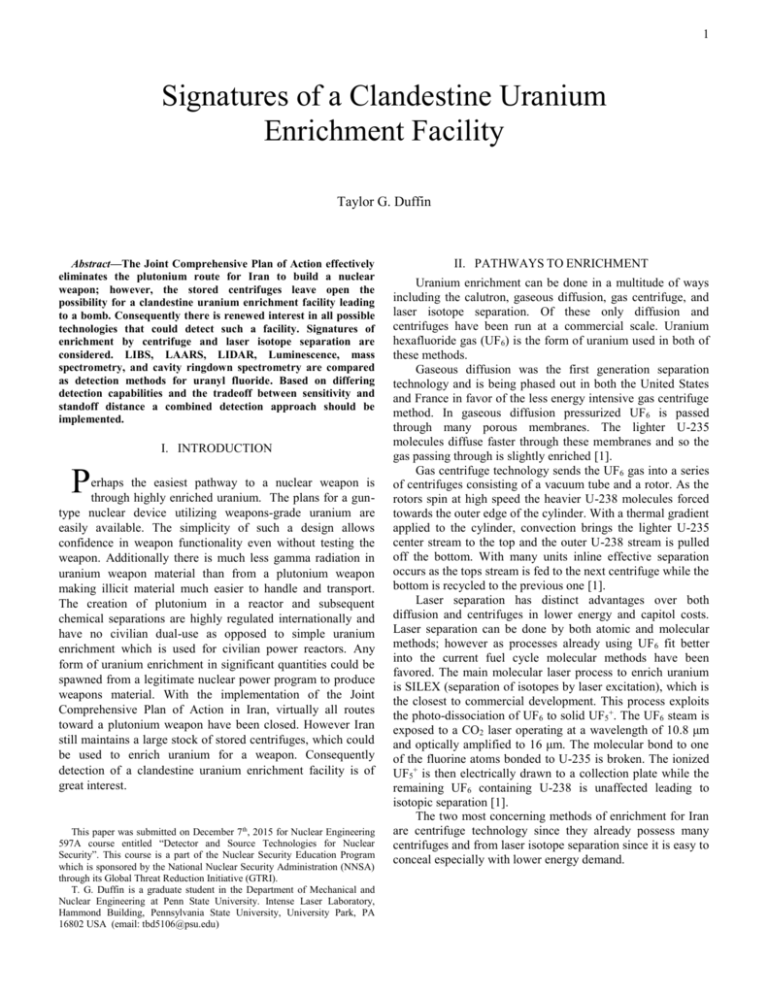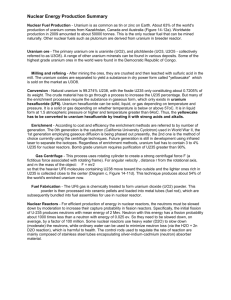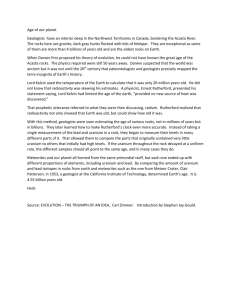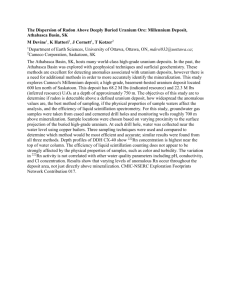UraniumEnrichmentv3 - WikiSpaces
advertisement

1 Signatures of a Clandestine Uranium Enrichment Facility Taylor G. Duffin Abstract—The Joint Comprehensive Plan of Action effectively eliminates the plutonium route for Iran to build a nuclear weapon; however, the stored centrifuges leave open the possibility for a clandestine uranium enrichment facility leading to a bomb. Consequently there is renewed interest in all possible technologies that could detect such a facility. Signatures of enrichment by centrifuge and laser isotope separation are considered. LIBS, LAARS, LIDAR, Luminescence, mass spectrometry, and cavity ringdown spectrometry are compared as detection methods for uranyl fluoride. Based on differing detection capabilities and the tradeoff between sensitivity and standoff distance a combined detection approach should be implemented. I. INTRODUCTION P erhaps the easiest pathway to a nuclear weapon is through highly enriched uranium. The plans for a guntype nuclear device utilizing weapons-grade uranium are easily available. The simplicity of such a design allows confidence in weapon functionality even without testing the weapon. Additionally there is much less gamma radiation in uranium weapon material than from a plutonium weapon making illicit material much easier to handle and transport. The creation of plutonium in a reactor and subsequent chemical separations are highly regulated internationally and have no civilian dual-use as opposed to simple uranium enrichment which is used for civilian power reactors. Any form of uranium enrichment in significant quantities could be spawned from a legitimate nuclear power program to produce weapons material. With the implementation of the Joint Comprehensive Plan of Action in Iran, virtually all routes toward a plutonium weapon have been closed. However Iran still maintains a large stock of stored centrifuges, which could be used to enrich uranium for a weapon. Consequently detection of a clandestine uranium enrichment facility is of great interest. This paper was submitted on December 7th, 2015 for Nuclear Engineering 597A course entitled “Detector and Source Technologies for Nuclear Security”. This course is a part of the Nuclear Security Education Program which is sponsored by the National Nuclear Security Administration (NNSA) through its Global Threat Reduction Initiative (GTRI). T. G. Duffin is a graduate student in the Department of Mechanical and Nuclear Engineering at Penn State University. Intense Laser Laboratory, Hammond Building, Pennsylvania State University, University Park, PA 16802 USA (email: tbd5106@psu.edu) II. PATHWAYS TO ENRICHMENT Uranium enrichment can be done in a multitude of ways including the calutron, gaseous diffusion, gas centrifuge, and laser isotope separation. Of these only diffusion and centrifuges have been run at a commercial scale. Uranium hexafluoride gas (UF6) is the form of uranium used in both of these methods. Gaseous diffusion was the first generation separation technology and is being phased out in both the United States and France in favor of the less energy intensive gas centrifuge method. In gaseous diffusion pressurized UF6 is passed through many porous membranes. The lighter U-235 molecules diffuse faster through these membranes and so the gas passing through is slightly enriched [1]. Gas centrifuge technology sends the UF6 gas into a series of centrifuges consisting of a vacuum tube and a rotor. As the rotors spin at high speed the heavier U-238 molecules forced towards the outer edge of the cylinder. With a thermal gradient applied to the cylinder, convection brings the lighter U-235 center stream to the top and the outer U-238 stream is pulled off the bottom. With many units inline effective separation occurs as the tops stream is fed to the next centrifuge while the bottom is recycled to the previous one [1]. Laser separation has distinct advantages over both diffusion and centrifuges in lower energy and capitol costs. Laser separation can be done by both atomic and molecular methods; however as processes already using UF6 fit better into the current fuel cycle molecular methods have been favored. The main molecular laser process to enrich uranium is SILEX (separation of isotopes by laser excitation), which is the closest to commercial development. This process exploits the photo-dissociation of UF6 to solid UF5+. The UF6 steam is exposed to a CO2 laser operating at a wavelength of 10.8 μm and optically amplified to 16 μm. The molecular bond to one of the fluorine atoms bonded to U-235 is broken. The ionized UF5+ is then electrically drawn to a collection plate while the remaining UF6 containing U-238 is unaffected leading to isotopic separation [1]. The two most concerning methods of enrichment for Iran are centrifuge technology since they already possess many centrifuges and from laser isotope separation since it is easy to conceal especially with lower energy demand. 2 III. DETECTABLE SIGNATURES Gaseous diffusion, gas centrifuges and the SILEX process all rely on a UF6 input stream. As UF6 is released it will hydrolyze rapidly in the air creating both uranyl fluoride (UO2F2) particulates and gaseous hydrofluoric acid (HF) according to the following chemical reactions. UF6 + 2H2 O → UO2 F2 + 4HF UF6 + H2 O → UOF4 + 2HF UOF4 + H2 O → UO2 F2 + 2HF (1) (2) (3) Both uranyl fluoride and HF can be detected by a variety of means. The particulates appear as a white aerosol cloud, which rises from the site of a leak and then disperses throughout the environment. The size of these particles range from 0.05-0.08 microns and agglomerate to form particles sized on the order of 1 micron [2]. The concentrations of the produced particles vary based on the relative humidity at the time of the release. If aerosol formation occurs under stoichiometric conditions then the atom number densities are: NHF ~ 2.4x1020 m-3, NUO2F2 ~ 0.7x1020 m-3 [3]. Large aerosols deposit by gravitational settling, and most aerosols are efficiently scavenged from the atmosphere by rain. However, fine and ultrafine aerosols can persist on time scales of 4 to 40 days [4]. The size range of large aerosol particles that settle to the ground is between 0.5 – 3.0 microns [5]. There are concerns that even at large scale enrichment facilities the total emissions of UF6 can be kept very low. As most piping and the centrifuges operate below atmospheric pressure, there is little leakage of the process gas to the atmosphere [4]. Large accidents resulting in much higher releases are seen as rare enough to not change the overall detectable quantities in realistic timescales [6]. Some have suggested that the detectable point will be at a clandestine conversion facility that supplies the enrichment facility [4]. Under either analysis the potential signals of uranium hexafluoride and its hydrolyzed products as well as their detection methods remain the same. Emission rates can be estimated by 1960’s U.S. conversion facility cited by Albright and Barbour, which leaked about 0.24 grams of uranium into the atmosphere for every kilogram of uranium in UF6 produced [7]. If this is scaled for a facility producing enough enriched material for a weapon annually then the release is 3.8 kg-UF6 per year or about 10 grams per day [4]. These concentrations will decrease with distance from the facility based on diffusion and wind conditions. The closer a detector can be to a facility the higher the likelihood of detection. Consequently detection technologies need to be extremely sensitive and be able to obtain a high amount of signal to relative noise even at very low concentrations. IV. CANDIDATE TECHNOLOGIES A. LIBS (Laser Induced Breakdown Spectroscopy) The setup for LIBS is relatively simple. A pulsed laser with a broad spectrum is directed at a target. The sample is exposed to the laser pulse and a small amount of material (ng) is ablated and forms a plasma that expands away from the sample surface. The various elements in the plasma, which are excited by the laser energy, relax to lower energy levels and produce characteristic photoemissions. These are detected by a spectrometer and subsequently can be identified. There is characteristic isotopic shift for highly enriched versus natural uranium with the proper experimental setup. The ablated surface does not need to be prepared beforehand. A diagram of a basic LIBS setup is shown in Figure 1. Fig. 1. Schematic diagram of a simple LIBS system (a) laser source and cooler; (b) pulsed laser head; (c) mirror; (d) focusing lens; (e) excitation chamber; (f) sample; (g) collecting optics; (h) optical fiber; (i) detector trigger signal; (j) wavelength selector; (k) detector array and (l) microcomputer. [8] Limitations to LIBS include the fact that decent amount of material is needed for a sequence of shots. Particles in an environmental swipe or deposited from an air filter may not be sufficient for multiple shots to improve the signal to noise ratio (SNR). LIBS can also experience a lot of potential interference by neighboring lines from different elements in the sample. It is difficult to be quantitative with LIBS because of these interferences. B. LAARS (Laser Ablation, Absorption Ratio Spectrometry) LAARS uses a laser ablating a surface similar to LIBS, however this ablation is used more to vaporize and eject the material rather than to excite it. The ablation still serves to atomize the material regardless of initial composition. The small ablation spot size also allows for spatial correlation on the sample. At 15 μs after the laser ablation the plasma will have cooled significantly to neutral atoms then two diode lasers tuned to specific wavelengths are passed through plasma. Photodetectors are inline with these lasers to measure the amount of intensity absorbed by the plasma. The intensity of the absorbance of the two beams is directly proportional to the enrichment level. A schematic of this process is shown in Figure 2. 3 There is little fluorescence response for solid-phase uranyl fluoride fallout material. It needs to be dissolved in acid solutions as the fluorine ions increase the fluorescence. This requires additional sample preparation and the process is very sensitive to the pH of the solution. Uranyl fluorescence can also be analyzed in a solid glass-state, but this is impractical to make from particulate samples [12]. Fig. 2. The Basic Components of the LAARS Instrument (Including a Compact Nd:YAG Laser, Two External Cavity Diode Lasers, the LAARS Sample Chamber, and the Absorbance Detectors. The diagram shows the sample chamber configured to characterize planar samples.) [9] This method eliminates much of the crosstalk between the different isotope emissions in LIBS, which can skew the enrichment level. Samples can be taken from collected aerosol particles, swipe samples or adsorbed vapor. There is virtually no sample preparation required. This technique can provide uranium enrichment analysis to within ±0.1% accuracy. For continuous monitoring aerosol particles can be captured by a rotating drum impactor and be ready for ablation [9]. A conceptual design for such an impactor is shown in Figure 3. D. LIDAR LIDAR uses a laser emission and its detected backscatter to determine the presence and distance of a target. This is often done with two different wavelengths that are closely spaced to compensate for fluctuations in one wavelength. This is called differential absorption LIDAR (DIAL). There is discussion of using a combined system with both DIAL and Raman scattering LIDAR. The DIAL system can provide information on the UF6 concentration using the off- and on-wavelengths at 266 nm at 245 nm, respectively, whereas Raman scattering of HF at 297.3 nm can identify and quantify HF [2]. A schematic of the proposed combined DIAL/Raman LIDAR system is shown in Figure 4. Fig. 4. Schematic diagram of combined differential absorption-Raman lidars for remote detection of UF6 [2]. Fig. 3. The Conceptual Rotating Drum Impactor [9] A similar rotating drum collection method could also be implemented with a LIBS system. C. Luminescence Laser-induced fluorescence (LIF) spectra of uranyl have a characteristic structure consisting of 6–8 bands in the interval from 470 to 630 nm with the most intense bands in the region of 470–530 nm [10]. Most of the luminescence in acidic HF solutions of uranyl fluorides arises from electronically excited UO2F2 (H2O)n. Thus, luminescence detection of UO2F2 is potentially a rapid, highly sensitive method for the detection of leaking UF6 cylinders, and the study of the fluorescence of UO2F2 is of particular interest [11]. In Raman scattering, the frequency of the scattered radiation is altered as a result of interaction of the photon with the energy levels of the molecules. This is a characteristic energy shift. Raman scattering is a weak process, and typically only 1 in 106 –108 photons undergo the Raman inelastic scattering event. This drawback may be compensated with the use of a high-power high-repetition-rate UV laser (on the order of several tens of Hz), a telescope with a large area, a sensitive PMT detector, and reducing background noise [2]. Raman is insensitive to water background. UV light in the solar blind region (200-310 nm) can enhance the Raman signal and improve SNR. SNR is variable between 1.5 to 120 based on integration time and the field of view. The minimum detectable concentration is 1.21 ppm at a range of 1000 m [2]. E. Mass Spectrometry Mass spectrometry is a highly used method throughout all of chemistry and its process details will not be described here. It is a standard method used by the IAEA for environmental samples. Typical environmental samples of uranium collected under IAEA guidelines. The samples are loaded on a filament and analysis is carried out by isotope-dilution (ID-TIMS) that gives quantitative and isotopic composition information or by 4 mass spectrometry for isotopic data only. The detection limit of the uranium signal was 107 atoms (~5x10-15 g); however due to background and blank levels, the practical detection limit is higher by two orders of magnitude. By a simpler extraction method the detection limit is 5 ng/cm2 on the surface or 40 ng/L [13]. F. Cavity Ring-Down Spectroscopy Cavity ring-down creates a long path-length over which light can travel by using a beam from a pulsed laser in a cavity with high reflectivity mirrors at each end. Each pulse of the laser enters the cavity and is reflected between the two mirrors, the light intensity decaying in time due to absorption and scattering by particles and gasses present between the mirrors. Each time the laser is reflected from the back mirror, a small fraction of light is transmitted through and is detected by a photomultiplier tube, the signal decay is then analyzed [13]. Cavity ring-down spectroscopy claims sensitivity down to parts-per-trillion. A recent study uses Saturated Absorption Cavity ring-down spectroscopy (SCAR) to reach parts-perquadrillion sensitivity on radiocarbon dioxide [15]. Cavity ringdown can only detect in a limited bandwidth. It is difficult to adjust to a different line for investigation as the cavity length is also involved in the analysis. This is in contrast to a method such as LIBS, which can detect many different emission lines from the same sample. Additionally, the flow of some neutral gas is needed in the cavity so that aerosols do not deposit themselves onto the sensitive optics. REFERENCES [1] [2] [3] [4] [5] [6] [7] [8] [9] [10] [11] V. METHOD COMPARISON [12] Most of these methods have excellent qualities in their specific circumstances. All can detect down to low concentrations. LAARS can detect down to femtograms U235. They claim uranium enrichment detection to within ±0.1% accuracy. SCAR looks like the lowest in terms of minimum detectable limit going down to part-per-quadrillion. It also has a 30:1 signal-to-noise ratio. LIDAR is excellent as a stand off technology. But it is much less sensitive if used at long distances. The minimum detectable concentration is 1.21 ppm at a range of 1000 m. A shorter distance can increase detectable and it has a good SNR if enough shots are taken. [13] VI. CONCLUSION There is no perfect technology to detect a clandestine enrichment facility. Many of these technologies would need to be used in conjunction to identify such a facility. LIDAR is an excellent method for measuring at standoff distance and the only method truly able to do so. LAARS could be used in the field if there was reasonable suspicion to collect environmental samples. SCAR has the lowest minimum detectable limit but would be difficult to make into a field usable device. Luminescent methods are like traditional mass spectrometry and take the analysis back to the lab with needed sample preparation and so may not add much to current techniques. [14] [15] World Nuclear Association (2015). Uranium Enrichment | Enrichment of uranium. Shayeganrad, G. (2013). On the remote monitoring of gaseous uranium hexafluoride in the lower atmosphere using lidar. Opt. Lasers Eng. 51, 1192–1198. I. I. Zherin, S. T. Penin, L. K. Chistyakova, and V. I. Kokhanov (1996). Experimental Study of the Aerosol Formation by Hydrolysis of UF6 in Gaseous Phase Under Atmospheric Conditons. J Aerosol Sci 27. Kemp, R.S. (2008). Initial Analysis of the Detectability of UO 2 F 2 Aerosols Produced by UF6 Released from Uranium Conversion Plants. Sci. Glob. Secur. 16, 115–125. Bostick, W. D., McCulla, U. H., Pickrell, P. W., & Branam, D. A. (1984). SAMPLING AND CHARACTERIZATION OF AEROSOLS FORMED IN THE ATMOSPHERIC HYDROLYSIS. analytical spectroscopy, 321. Boesenberg, J., and Kalinowski, M. (2008). Detecting Atmospheric UF6 and HF as Indicators for Uranium Enrichment. INESAP Bulletin 28, 55– 59. Albright, D., and Barbour, L. (1997). Source terms for uranium enrichment plants. Institute for Science and International Security. Compiled for the US Support Program to the IAEA for Wide-Area Environmental Sampling and Available as an Appendix to IAEA Report STR-321. Pasquini, C., Cortez, J., Silva, L., and Gonzaga, F.B. (2007). Laser induced breakdown spectroscopy. Journal of the Brazilian Chemical Society 18, 463–512. Boyer, B., Anheier, N., Cable-Dunlop, P., and Sexton, L. (2013). Incorporation of New, Automated Environmental Sampling Systems into Safeguards Approaches (Los Alamos National Laboratory (LANL)). Grigor’ev, G.Y., Nabiev, S.S., Malyugin, S.L., Sukhanova, M.A., Nadezhdinskii, A.I., and Ponurovskii, Y.Y. (2008). Laser-spectroscopic techniques for monitoring releases from nuclear fuel cycle objects. At. Energy 105, 280–289. [Wang, Q., and Pitzer, R.M. (2001). Structure and spectra of UO2F2 and its hydrated species. The Journal of Physical Chemistry A 105, 8370– 8375. Reisfeld, R., Eyal, M., and Jørgensen, C. (1986). Spectroscopy of uranyl ions in a fluoride glass. Chemical Physics Letters 132, 252–255. Karpas, Z. (2014). Analytical Chemistry of Uranium: Environmental, Forensic, Nuclear, and Toxicological Applications (CRC Press). Mack, L.E. (2008). Cavity Ring-down Spectroscopy and the Retrieval of Aerosol Optical Properties from Biomass Burning During Flame2. Colorado State University. Galli, I., Bartalini, S., Borri, S., Cancio, P., Mazzotti, D., De Natale, P., and Giusfredi, G. (2011). Molecular Gas Sensing Below Parts Per Trillion: Radiocarbon-Dioxide Optical Detection. Physical Review Letters 107.








